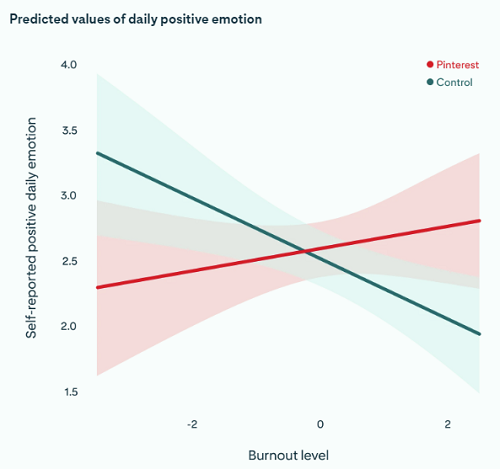Pinterest is looking to differentiate itself from other social apps, by highlighting how its systems are built to facilitate more positive, beneficial experiences, as opposed to addictive, compulsive behaviors.
Via a new study with UC Berkeley’s Greater Good Science Center, Pinterest says that daily interaction with inspiring content in the app helped Gen Z college students to buffer against burnout and stress, ‘even when they were studying for stressful college exams’.
Though the study was somewhat unusual – Pinterest had a group of study participants either use Pinterest for 10 minutes per day or solve online jigsaw puzzles for same amount of time, consistently over two weeks. The comparison was designed to give some measure of differential benefit between using Pinterest or conducting another neutral activity.
The researchers found that as the end of year exams period approached, stress and anxiety levels in the participants increased:
“However, in students assigned to the Pinterest condition, we found that just 10 minutes a day seeking out inspiration buffered against the rising burnout, stress and social disconnectedness we could see in their vagal tone data. This had consequences for emotional wellbeing, physical health and social connectedness.”

The study also found that active engagement with inspiring content on Pinterest ‘mitigated the consequences of physical stress on people’s daily positive emotion, preserving their capacity for feeling good’, while social connectedness also increased.
“We also found that higher levels of inspiration make it easier to relax. This higher level of relaxation was uniquely “unlocked” by seeking inspiration on Pinterest, and was not true of the control condition.”
It’s an interesting study, and while the comparison between online puzzles and Pinterest use may not be wholly indicative of universal benefits of using Pinterest, it does provide some measure of how the platform can encourage positive emotions and experiences.
In addition to this, Pinterest has also outlined how its efforts on this front have varied from other platforms, as it’s sought to align its tools around more healthy interactions, as opposed to optimizing for raw engagement.
“Over the last decade, we’ve made deliberate choices to engineer a more positive place online. For example, our algorithm prioritizes explicit signals from people who use Pinterest: more conscious, active engagements, like “saving” an idea. We use those active signals to determine what you see first on Pinterest.”
Pinterest says that social platforms should be more intentional about the content they rank, and more realistic about the effects it can cause.
“Ranking for views can certainly promote some great, entertaining content, but unfortunately it’s just as good at surfacing divisive and polarizing content that keeps people hooked. If we are going to curb the crisis that social media has created, the only option is to tell AI to do something different.”
Pinterest says that it’s looking to buck this trend by focusing on ‘inspired actions’, and direct user signals, in order to only show people what they want to see, not what will keep them scrolling, necessarily.
“A good example of one of those actions is ‘saves’. When people see something on Pinterest that they want to act on, they hit ‘save’. And when we prioritize what gets ‘saved’ in the content we show people first on the platform, suddenly the images and videos that are top-performing don’t distract you from your life (like gross-out videos or conspiracy theories), but actually help you improve it (like step-by-step guides, self-care ideas, inspirational quotes, how-to videos). Simply by telling AI to prioritize something more nourishing, we can build a more positive and inspiring internet.”
Pinterest also highlights its policies to protect teens, its inclusive features and other elements designed to make it a more welcoming, positive social media space.
It’s an interesting consideration, and it’s something that most social platforms have at least voiced, in regards to the desire to create more meaningful, beneficial experiences, as opposed to maximizing time spent. But at the same time, user counts and time spent are key metrics for social platforms, so it makes sense that they’re looking to optimize for these metrics – which, as Pinterest notes, can also see negative content amplified, as argument and division are core elements in ‘engagement’ via comments responses.
It’s good to see Pinterest taking a more definitive stand on this, and while the comparison study may not feel like a definitive argument for its full benefits, it does give some indication that Pinterest usage can lead to positive and beneficial experiences.
You can read the full study here, and Pinterest’s overview of its approach here.



